CONSTRUCTING THE HARBOUR OF CAESAREA ON THE
SEA: NEW EVIDENCE FROM THE ROMACONS FIELD CAMPAIGN OF OCTOBER 2005.
(A slightly different version was published in The International Journal of
Nautical Archaeology,
2007. 36.2: 409-15)
Background
In approximately one decade (c. 23-15 BCE),
local and Roman builders working for King Herod of Judaea constructed the
largest artificial harbour ever built in the open sea up to that point. The
scale and complexity of this project, along with the rapidity of its execution,
are remarkable even if judged by modern standards. It ranks as one of the most
impressive engineering accomplishments of the Augustan Age (Figure: Aerial
photograph of harbour).
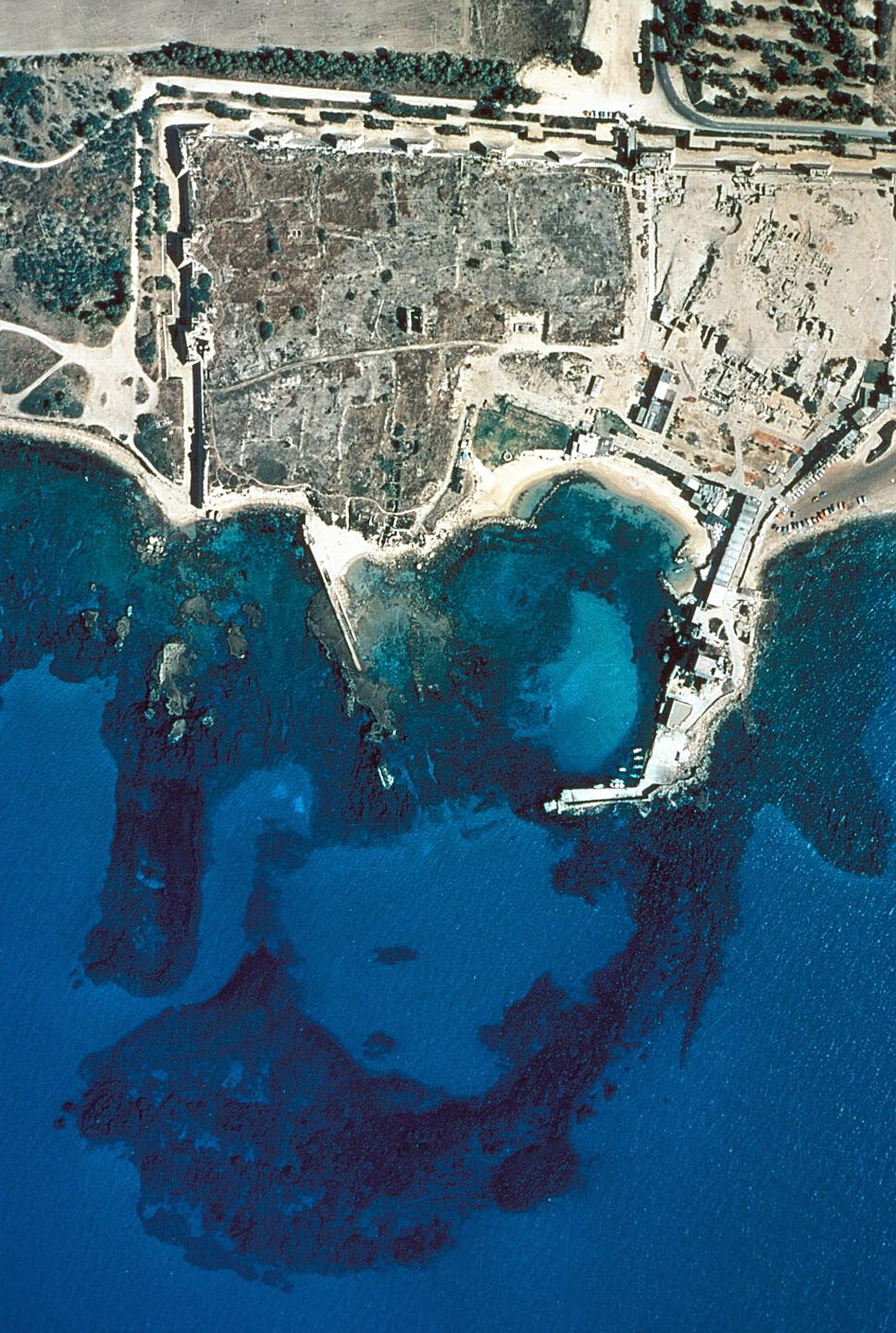
Named Sebastos (the Greek equivalent of
Augustus), the harbour of Caesarea Palaestine, also known in Greek as Caesarea
on the Sea, was
founded on a shifting sand beach devoid of any mitigating physical features.
The shoreline was exposed to the longest fetch in the Mediterranean and scoured
by a strong long-shore current that carried sand from south to north. The site
had been selected primarily for political reasons, not because nature favoured
the construction of a port at this location (Holum and Hohlfelder 1988). Once
the royal decision had been made, it was up to King HerodŐs builders to execute
his desires, even though they faced design and construction challenges never
before encountered by Mediterranean harbour engineers (Hohlfelder, 2000 and
2003). Underwater excavation and exploration have been carried out in the
submerged ruins of HerodŐs vast harbour complex almost continuously since 1960
in an effort to understand how this daunting ancient engineering project was
executed so quickly and expertly in the face of seemingly insurmountable
obstacles. The bibliography on the underwater excavations at Caesarea
Palaestinae is considerable. Most published works relevant to this article are
listed in the references section of Oleson et al. 2004, 228-9.
This archaeological research has produced a vast literature that has revealed
some, but not all, of the secrets of Sebastos.
Since 2002, the Roman Maritime Concrete Study
(ROMACONS) has been conducting fieldwork in Italy, collecting cores from
maritime structures constructed of Roman hydraulic concrete, and building an
underwater reproduction of a pila or pier using materials and tools that would
have been available to Roman builders (Oleson et al., 2004a, 2004b; Hohlfelder et al., 2005; Oleson et al., 2006). So far, we have collected
cores from Roman maritime structures at Portus, Anzio, Cosa, Santa Liberata,
and Baia. Roman hydraulic concrete consisted of a mortar made from lime,
pozzolana (a sand-like volcanic ash naturally rich in aluminosilicates), and
water, to which various types of rubble aggregate was added. The resultant
mixture was a hard and durable concrete that could solidify underwater. While
still in a liquid or plastic state, it could be placed in wooden formwork of
various shapes and sizes to form monolithic masses, including structures known
to the Romans as pilae. The research program of ROMACONS has several aims: to document the
physical and mechanical properties of Roman hydraulic concrete through
exhaustive testing of our sample cores in the laboratories of CTG Italcementi
Group in Bergamo, Italy; to understand the various methods employed by ancient
builders in casting this material in marine environments; to determine the
sources of the ingredients used in its composition; and to identify
geographical or chronological variations in Roman hydraulic concrete during the
six or more centuries it was used in marine constructions throughout the
Mediterranean world.
In
October 2005 ROMACONS was able to extend its research efforts beyond the
Italian peninsula to Israel, where we retrieved five concrete cores from the
extensive remains of concrete blocks that survive from the submerged
installations of King HerodŐs harbour.
It was the first ROMACONS expedition in which all samples were taken
from well below present sea level with the use of SCUBA. Furthermore, Sebastos
is the first imperial harbour that we have sampled in a fairly comprehensive
manner, obtaining cores from a variety of types of structural blocks and from a
judicious spread of locations around the harbour facility. At Antium (Anzio) in
2002 we recovered only a single core, and the five cores taken from the
Claudian and Trajanic installations at Portus at the mouth of the Tiber River
in the same year may not be completely representative of the array of
structures that made up the harbour complex. The five cores taken from the
Republican harbour of Cosa in 2003 represent a more comprehensive sample, but
they were from a smaller, early harbour.
At
Caesarea we were confronted with a plethora of potential targets. Vast numbers of concrete blocks unencumbered
by rubble or post-Classical ruins dot the seafloor. We could only core five
structures, but by careful selection we believed this number would provide a
reasonable sample of the whole. Previous underwater investigations at Caesarea
had revealed at least three different methods employed by ancient builders to
allow the hydraulic concrete to set and cure in a marine environment while
contained within wooden shuttering. Why the builders employed at least three
variants of formwork in different locations in the harbour rather than
standardizing delivery and casting protocols is
unclear at this time. But this creative design is one of the most striking
features of HerodŐs engineering project.
One method employed a box either formed of vertical planks pounded into the ocean floor and then supported by exterior and/or interior horizontal cross beams or by reversing this procedure and pounding the beams in first and affixing the planks to them. (Figure: Vitruvian formwork).
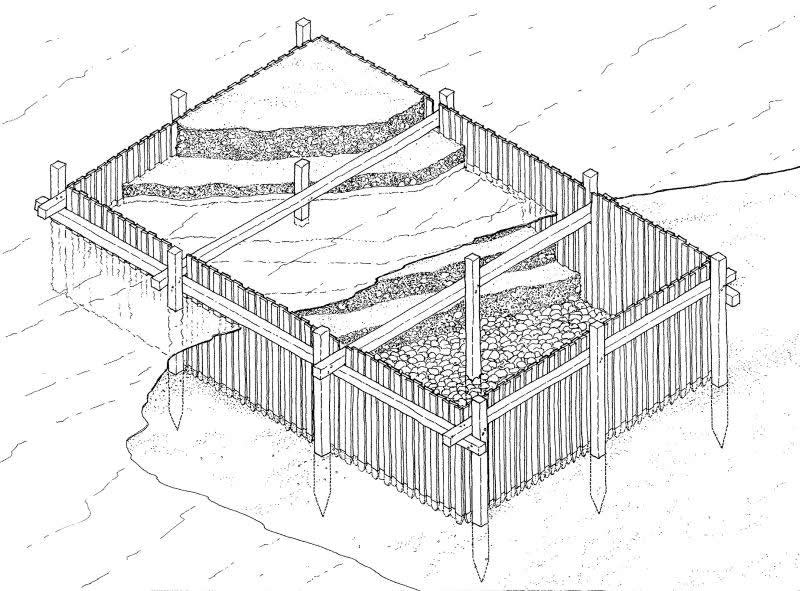
Once the wooden formwork was in place, concrete was placed within
the box to set and then cure. This method was mentioned by Vitruvius, De
Architectura, (c.
25 BCE) and was employed with local variations extensively throughout the Roman
world (Oleson, 1985; Oleson, 1988; Brandon, 1996; Brandon, 1999; and Oleson et
al., 2004a, 2004b, 2006). Three cores were extracted from concrete blocks that
were structural elements of the Southern Breakwater. One (CAE 2005.2) certainly
had been constructed using more or less the Vitruvian method. The other two
(CAE.2005.4 and CAE.2005.5) may have been as well, although their method of
construction has not been absolutely resolved.
The second method, discovered by excavators associated with the Caesarea Ancient Harbour Exportation Project (CAHEP, co-directed by two of the authors – Hohlfelder and Oleson), employed a containment system for the concrete that featured a large double-walled hollow box (c.11x15x4m) that was constructed on shore and towed into position (Figure: Reconstruction of floating form being positioned. Copyright National Geographic Society).
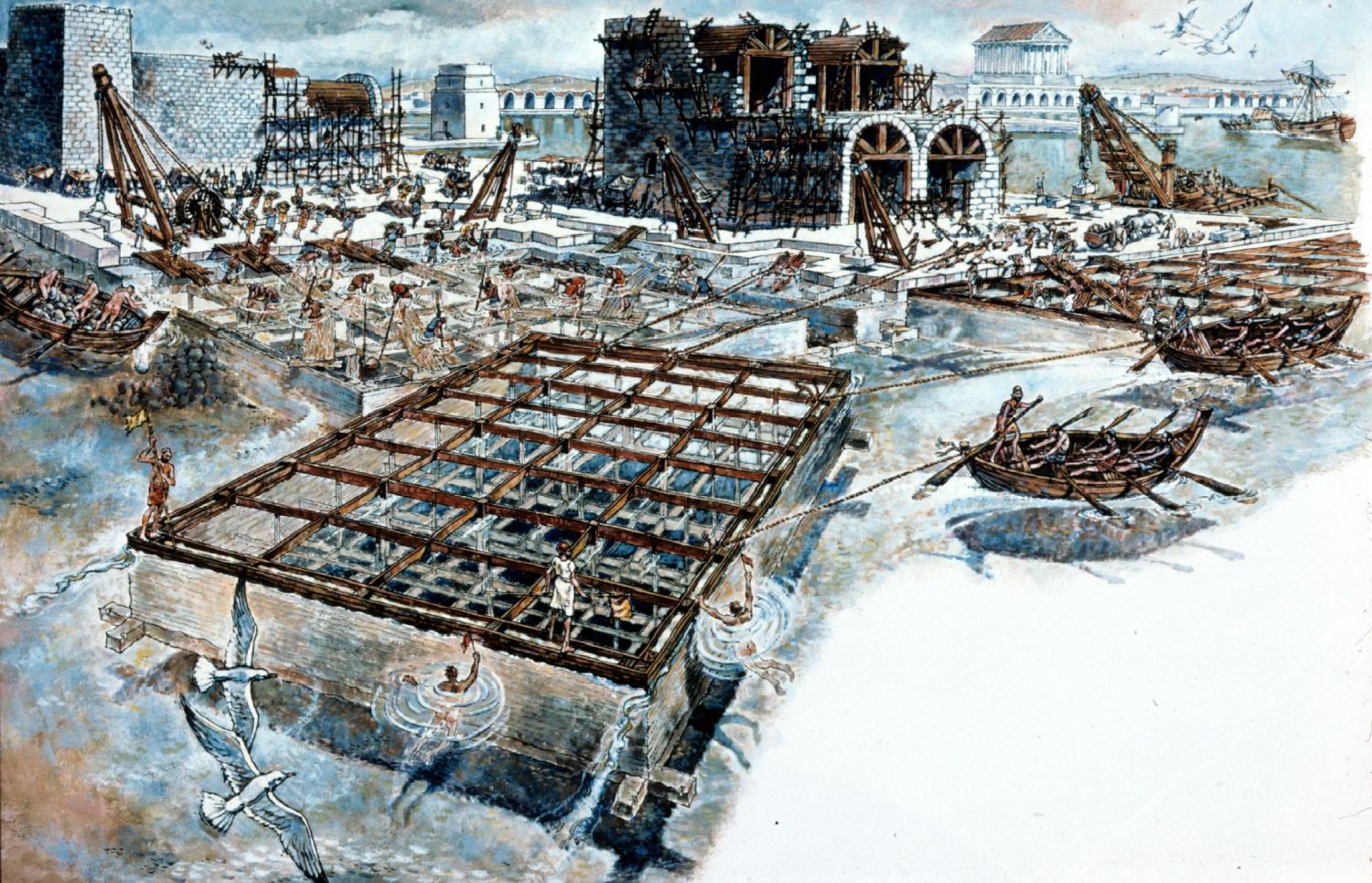
Once in location, the space
between the two walls was filled with mortar until the formwork sank to the
bottom. Only then was it filled with concrete (Oleson, 1985; Oleson, 1988;
Hohlfelder, 1987, 264-5). CAE.2005.03 was taken from the block cast in this
formwork that marked the terminus of the Northern Breakwater- CAHEPŐs Area G
(Oleson, 1989).
The third method was a variant of the second. Barges built with horizontal planks linked by mortise-tenon joinery were constructed on or near shore and towed into position. We believe that they had most likely been partially filled with concrete in shallow water to reduce their freeboard and susceptibility to the winds and waves and thus facilitate their transport to the desired location. When the barges had been towed to the desired location, they were topped off with concrete until they sank to the bottom (Figure: Reconstruction of barge forms in use. Copyright C. Brandon).
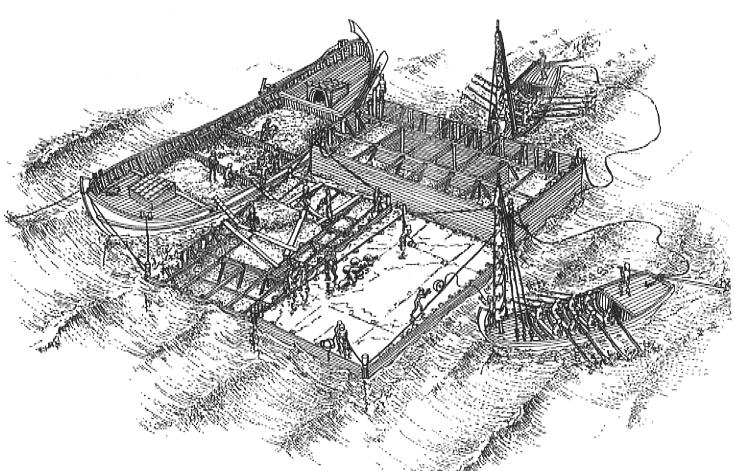
This method of placement has been
studied and discussed extensively by C. Brandon who has conducted underwater
investigations at this site from 1990 to the present in conjunction with the
late Avner Raban and other scholars associated with the University of Haifa A core
was extracted from a block cast in
this method that had been identified by earlier excavators as Area K5
near the terminus of the Northern Breakwater. (Brandon, 1996, 1997, 1998).
The major purpose of our collection of cores was to compare the Caesarea samples to the database that ROMACONS has already amassed from Italian sites. These findings will be published as the results of mechanical and physical tests conducted at the CTG Italcementi laboratory become available. These data will add to our expanding knowledge of the nature and characteristics of hydraulic concrete during its centuries of use by the Romans and the spread of maritime harbour technology throughout the Roman world. The coring equipment and protocols used for collecting these cores have been described in detail elsewhere (Oleson et al., 2004). No major modifications were necessary to complete our fieldwork at Caesarea (Figure: Coring in progress).
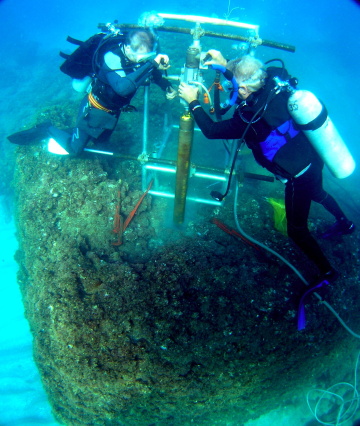
ROMACONS 2005 Cores:
Cores were extracted from submerged concrete blocks that were structural elements of the Southern Breakwater and one from the terminus of the northern breakwater that delineates the eastern face of the harbour mouth. (Figure: Aerial of harbour with indication of coring sites).
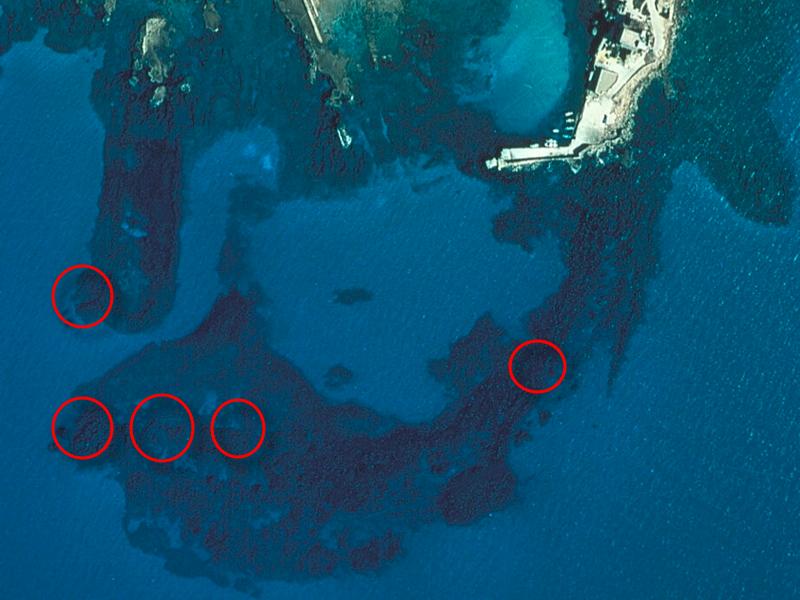
CAE.2005.01.
06/10/05. K5 on Southern Breakwater.
Depth on top of block: 3.5m. Depth of core hole: 1.10 m.
Total length of core: 1.10m. Proportion recovered: 100%
Comments: Coring stopped when wood was encountered, probably a horizontal tie beam. A cavity left when by an exposed element was visible on the western side of the block. We recovered four solid, joining fragments with no apparent loss of material. The largest fragment was L 0.60 m. The base of the core was rough, and the lowest 0.10 m recovered was moist, as was the top 0.10 m, suggesting inflow through the beam hole. The top of core carried marine incrustation.
CAE.2005.02.
07/10/2005. Block
on Southern Breakwater with tie beam marks on upper surface on CAHEP Survey
Line 3.
Depth on top of block: 3.0 m. Depth of core hole: 1.65 m.
Total length of core: 1.65 m. Proportion recovered: 100%
The coring appeared to have penetrated the entire block, since the
coring tube began to run easily before coring was terminated. Five solid,
joining fragments were recovered; the longest was L 0.59 m, while the shortest
L 0.08. There was no apparent loss of core. The upper and lower ends are darker
green because moist from exposure to sea water.(Figure: View of core CAE.2005.02).
CAE.2005.03.
09/10/2005. Area G on northern breakwater, NW corner edge of block.
Depth on top of block: 3 m. Depth of core hole: 1.00 m.
Total length of core: ca. 0.80m, but most of it was crumbled. Proportion
recovered: ca. 60%
Comments: The core was very fragmentary, either because of the softness of the concrete, or as a result of the action of the coring barrel, which jammed several times in the top 0.10 m. The longest fragment was L 0.15 m. There was kurkar aggregate at the top and bottom of the core; portions of the core seem to have come loose from the mortar during the extraction process only to be ground up by the core bit.
CAE.2005.04.
10/10/2005. Area south of K on southern breakwater.
Depth at top of block: 3 m. Depth of core hole: 2.30-2.40 m.
Total length of core: 2.10 m. Proportion recovered: 91.3%
Comments: The coring penetrated through to the lower surface of the block. There seemed to have been some loss of material at the crumbly section between -1.5 to -1.8 m. There were marine encrustations on both the top and bottom of the core. Nine fragments, largest L 0.60 m; shortest 0.05 m.
CAE.2005.05.
11/10/2005. Area
CO on southern breakwater.
Depth at top of block: 2.5 m. Depth of core hole: 2.0 m
Total length of core: 1.95 m. Proportion recovered: 97.5%
Comments: The irregularity of the upper surface of the block, along with a strong surge, made mounting of the coring frame very difficult. Coring was slowed by the hardness of the kurkar aggregate, and by fragmentation of the upper 0.03 m of the block, which jammed the corer. There was time to take only the 2.0 m recovered.
Analysis
Following a detailed physical inspection in the field the cores are now being studied in the laboratories of Italcementi (Figure: Oleson during field examintion of core).
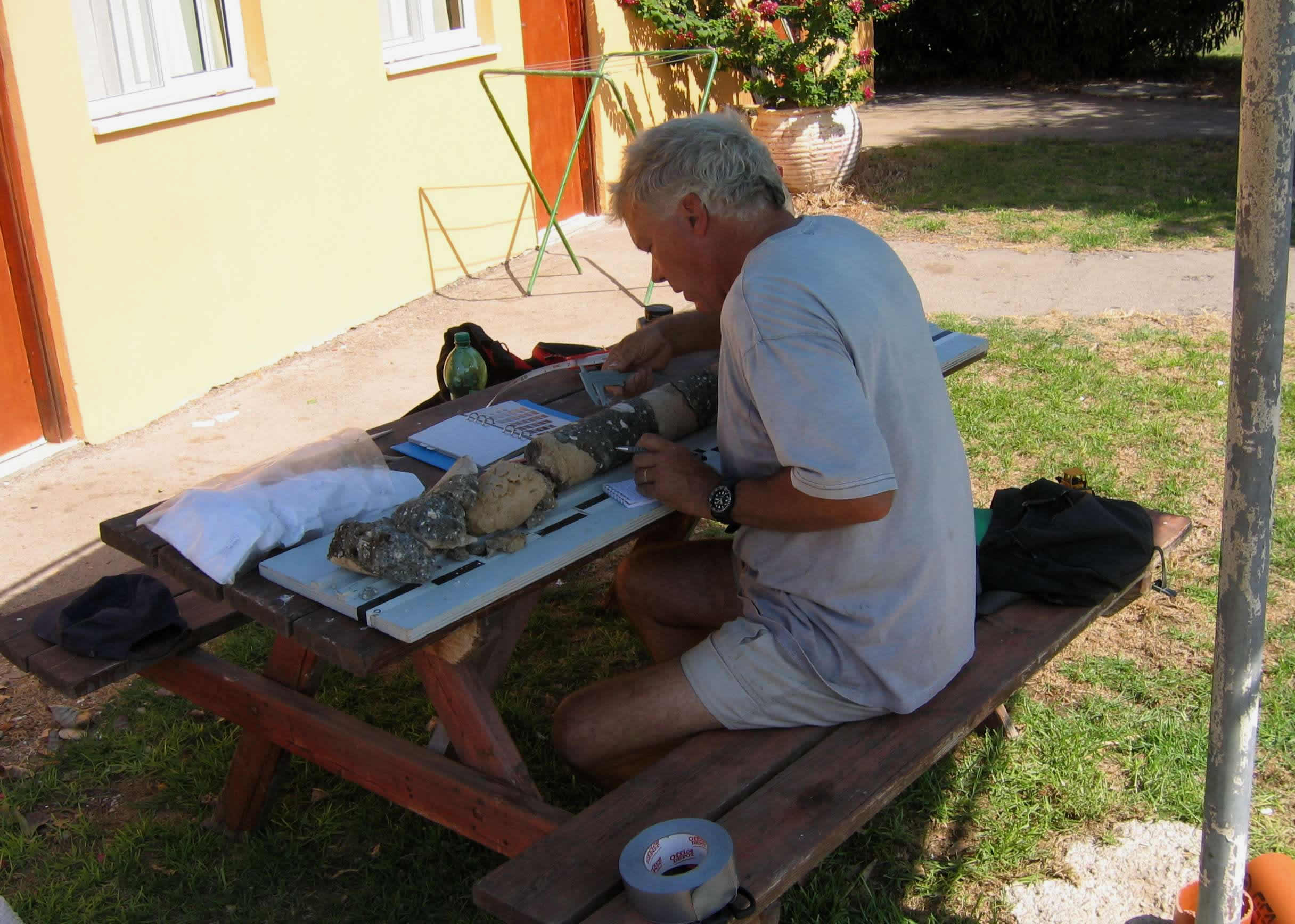
Tests include
calculation of the ratios of aggregate and mortar; analysis of the composition
of the aggregates to determine particle size and distribution and weights of
each fraction; determination of the dynamic modulus of elasticity and
compressive strength; air void analyses; petrographic analyses of aggregates
and paste fractions; elemental analysis of lime and pozzolana fractions by
X-Ray diffraction and SEM to determine the origin of the materials; and mercury
intrusion porosity tests. While the definitive results of these tests are not
yet available, it is possible to make some general observations about the
Caesarea cores:
CAE.2005.01, 02, 04 and 05 resemble each other
closely in composition and visual appearance. Virtually all the aggregate with
a diameter greater than 0.02 m consists of kurkar, the local carbonate cemented
aeolianite sandstone that occurs throughout the region in ridges parallel to
the modern shoreline. The smaller, non-kurkar aggregate in these cores has
taken on a greenish-blue colour, and most of it has the fibrous appearance of
pumice rather than tuff. Given the absence of large aggregate composed of tuff,
the pumice probably arrived with the bulk shipments of pozzolana as part of the
quarry mix. Numerous similar pumice lapilli appear in the pozzolana deposits around Baia
and Pozzuoli in Italy (the source of the material for Caesarea). During
construction of our experimental pila at Brindisi in 2004 (Hohlfelder et al. 2005; Oleson et al. 2006), many of these lapilli escaped from the wet mortar and
floated to the surface of the water in the form during placement of the
concrete. The exclusive use of local kurkar for aggregate makes economic sense.
Even though this stone served as the caementa, the builders maintained a ratio of aggregate
to mortar similar to that we have found elsewhere. Although the kurkar is porous and sponge-like, our
impression is that the mortar in the Caesarea cores does not adhere as well to
this aggregate as it does to the tuff aggregate used in Italy. Preliminary
analysis indicates that the pozzolana used in the mortar was imported from the
region around Pozzuoli. It has also been determined that the chemical
parameters of the mortar are comparable with our Italian samples, in particular
with our Ňbench-markÓ data from Santa Liberata.
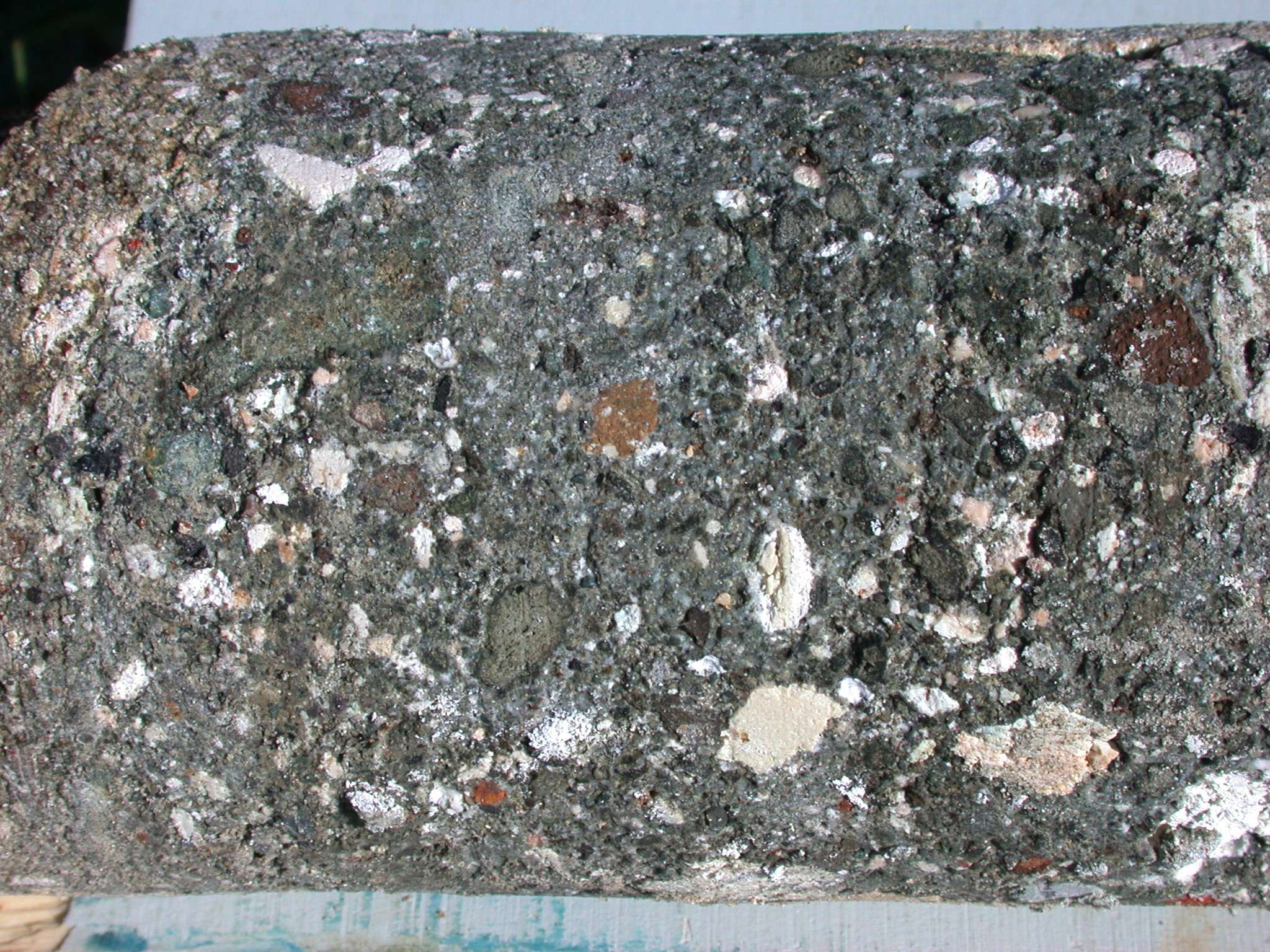
Many of the larger lumps of lime in all five of
these cores show a pattern of thin, alternating black and white stripes, which
we have not seen in cores at other sites. They were most likely formed during
the initial stages of working the pozzolana into the wet lime and consist of
lumps that were chopped or mixed several times in the initial stages of working
but then somehow left unreduced. In general, the visual impression is that
small lumps of unmixed lime are more frequent in the CAE.2005 cores than in
those from the Italian sites we have sampled. Possible explanations are: the
conditions of construction on the open sea either required faster, more
careless preparation of the mortar mix, or the conditions for mixing (on board
ship?) were more difficult; the local workers were less skilled in the
procedure or more diffident than those in Italy. The numerous uniform small
voids also set the CAE.2005 cores apart from those taken in Italy. Perhaps wave
action at the unprotected construction site incorporated bubbles in the mortar
mix during placement, or the construction conditions impeded manual compaction,
or the higher water temperature accelerated the rate of setting and precluded
self-compaction.
The concrete forming CAE.2005.03 is much less
cohesive than that of the other cores, although it seems to have made use of
the same materials. The lumps of unmixed lime may be more frequent in this
sample, suggesting a possible source of weakness, if in fact much of the mix
was poor in lime as a result. It is also possible that rough water conditions
washed out some of the lime before the mix had time to set, or that the mix was
too wet when laid. Another source of weakness could be mechanical damage during
settling of the block. This is a large, relatively thin block, laid on sand. It
is possible that numerous cracks have developed over the last 2000 years,
allowing accelerated weathering throughout the mass.
All of the Caesarea cores were substantially
weaker than the Italian cores that have been tested, CAE.05.01 and 05 showing
less than half the compressive strength of a sample from Santa Liberata
(SLI.04.01). The YoungŐs Modulus (essentially a measure of the internal
cohesion and flexibility of the material) varied significantly among the
samples; it is interesting that CAE.05.01 had a YoungŐs Modulus approximately
equivalent to that of SLI.04.01, while that of CAE.05.05 was only half the
value.
In summary, the concrete at Caesarea, while
constructed with pozzolana from the Bay of Naples, presents a different
appearance than contemporary concretes in Italy, as a result of the distance
from sources of pozzolana and tuff, the location of the construction site on an
unprotected sea shore, and possibly the use of a workforce unaccustomed to
working with hydraulic concrete. Brandon (1999: 173-75) has already commented
on the great variation in the quality of concrete recovered inside the
barge-forms in Area K, near the tip of the southern breakwater. Brandon has
recently calculated that approximately 35,000 cubic m of concrete was used in
the construction of Sebastos, requiring the importation of 24,000 cubic metres
of pozzolana (ca. 52,000
tons), the quarrying of 12,000 cubic m of solid kurkar (to be reduced to rubble before
use), and the production of 12,000 cubic m of slaked lime. The pozzolana alone
would have constituted approximately 100 to 150 large shiploads. Some of these
ships may have been grain freighters that carried grain from Alexandria to
Puteoli (for transhipment to Rome) and then returned with either ballast or a
full cargo of pozzolana. Given the length of this voyage, and possibly the need
to coordinate the construction of the harbour not only with weather and the
more typical supply problems of an enormous project but also with the grain
trade, it would be no surprise if shortages of the crucial pozzolanic additive
developed from time to time. The use of local aggregate must have seemed a
natural decision under these circumstances, but it now seems likely that kurkar was not an adequate substitute for
tuff. This combination of supply problems, inexperience, and a very difficult
construction site resulted in the production of an inferior, but still
remarkably durable, concrete cast in various types of wooden formwork more than
2,000 years ago.
Robert
L. Hohfelder
Department
of History University of Colorado
Boulder,
CO USA
Christopher
Brandon
Pringle
Brandon Architects, 10 Bonhill St.
London
EC2A 4 QJ, UK
John
P. Oleson
Department
of Greek and Roman Studies
University
of Victoria
Victoria
BC V8W 3P4, Canada
Acknowledgements
The directors of ROMACONS are indebted to many people and institutions
for their support and assistance in helping this project become a reality. Dr.
Luigi Cassar of CTG Italcementi Group, Bergamo has encouraged and aided our
research in so many ways since its outset through our fieldwork in 2005. We
also acknowledge and thank his successor, Enrico Borgarello, for continuing to
endorse and assist our project as we look to the future. We are also deeply
grateful to their colleagues, Mr. Dario Belotti, Ms. Isabella Mazza, and Mr.
Massimo Borsa, for providing invaluable logistical support and to Dr. L.
Bottalico, Dr. R. Cucitore, Dr. E.
Gotti and Dr E. Vola for their scientific expertise.
We especially thank Professor Michal Artzy, of the Recanati Institute
for Maritime Studies of the University of Haifa without whose backing this
project would not have been possible. We also acknowledge and thank the help given
by Dr YaŐacov Kahanov, Yossi Tur-Caspa and Amir Yurman for their invaluable
contributions to our fieldwork. We
thank John Tresman, Mosheko Bachar and Omri Ben-Eliyahu for their assistance
and particularly Greg Votruba for his help underwater and his skills as a
photographer.
References
Brandon,
C., 1996, Cements, Concrete, and Settling Barges at Sebastos: Comparisons with
other Roman Harbor Examples and the Descriptions of Vitruvius, in A. Raban and
K. G. Holum (eds), Caesarea Maritima: a Retrospective after Two Millennia, 25–40. Leiden.
Brandon,
C., 1997, The Concrete-Filled Barges of King HerodŐs Harbor of Sebastos, in S.
Swiny, R. L. Hohlfelder, and H. W. Swiny (eds), Res Maritimae: Cyprus and
the eastern Mediterranean from Prehistory to Late Antiquity, 45–58. Atlanta.
Brandon,
C., S. Kemp, and M. Grove, 1999,
Pozzolana, Lime, and Single-mission Barges (Area K), in K. Holum et al. (eds), Caesarea Papers 2, Journal of Roman Archaeology
Supplementary Series 35: 169-172. Portsmouth,
Rhode Island.
Hohlfelder,
R. L., 2000, Beyond coincidence? Marcus Agrippa and King HerodŐs Harbour, Journal
of Near Eastern Studies 59:
241–53.
Hohlfelder,
R.L. 2003. Images of Homage, Images of Power: King Herod and his Harbour,
Sebastos, Antichthon 37:
13-31.
Hohlfelder,
R.L., C. Brandon and J.P. Oleson, 2005. Building a Roman Pila in the Sea—Experimental
Archaeology at Brindisi, Italy, September 2004, International Journal of
Nautical Archaeology
34, 123-27.
Holum, K.G and R.L. Hohlfelder, 1988. King HerodŐs Dream. New York.
Oleson,
J. P., 1985, Herod and Vitruvius: Preliminary Thoughts on Harbour Engineering
at Sebastos, the Harbour of Caesarea Maritima, in A. Raban (ed.), Harbour
Archaeology. Proceedings of the First International Workshop on Ancient Mediterranean
Harbours, Caesarea Maritima,
24–28.6.83, BAR Int. Series
257, 165–72. Oxford.
Oleson,
J. P., 1988, The technology of Roman Harbours, IJNA 17,
147–58.
Oleson,
J.P., 1989, Area G: NW Tip of Northern Breakwater and Adjacent Tower, in A.
Raban (ed.). The Harbours of Caesarea Maritima, Volume 1: The Site and
Excavations, BAR Int. Series 491,
127-30. Oxford.
Oleson, J.
P., C. Brandon, S. Cramer, R. Cucitore, E. Gotti and R.L. Hohlfelder, 2004a.
The ROMACONS Project: A Contribution to the Historical and Engineering Analysis
of Hydraulic Concrete in Roman Maritime Structures, International Journal of
Nautical Archaeology
33, 199-229.
Oleson,
J.P., C. Brandon and R.L. Hohlfelder, 2004b. The Roman Maritime Concrete Study
(ROMACONS): Fieldwork at Portus, Anzio, Santa Liberata, Cosa, 2002-2003, in F.
Maniscalco (ed.), Mediterraneum. Tutela e valorizzazione dei beni culturali
ed ambientali Vol. 4, Tutela del patrimonio culturale sommerso—Protection
of Underwater Cultural Heritage, 185-94. Naples.
Oleson, J. P., L. Bottalico, C. Brandon, R. Cucitore, E. Gotti, and R.L.
Hohlfelder, 2006. Reproducing a Roman Maritime Structure with Vitruvian
Pozzolanic Concrete, Journal of Roman Archaeology 19: 29-52.